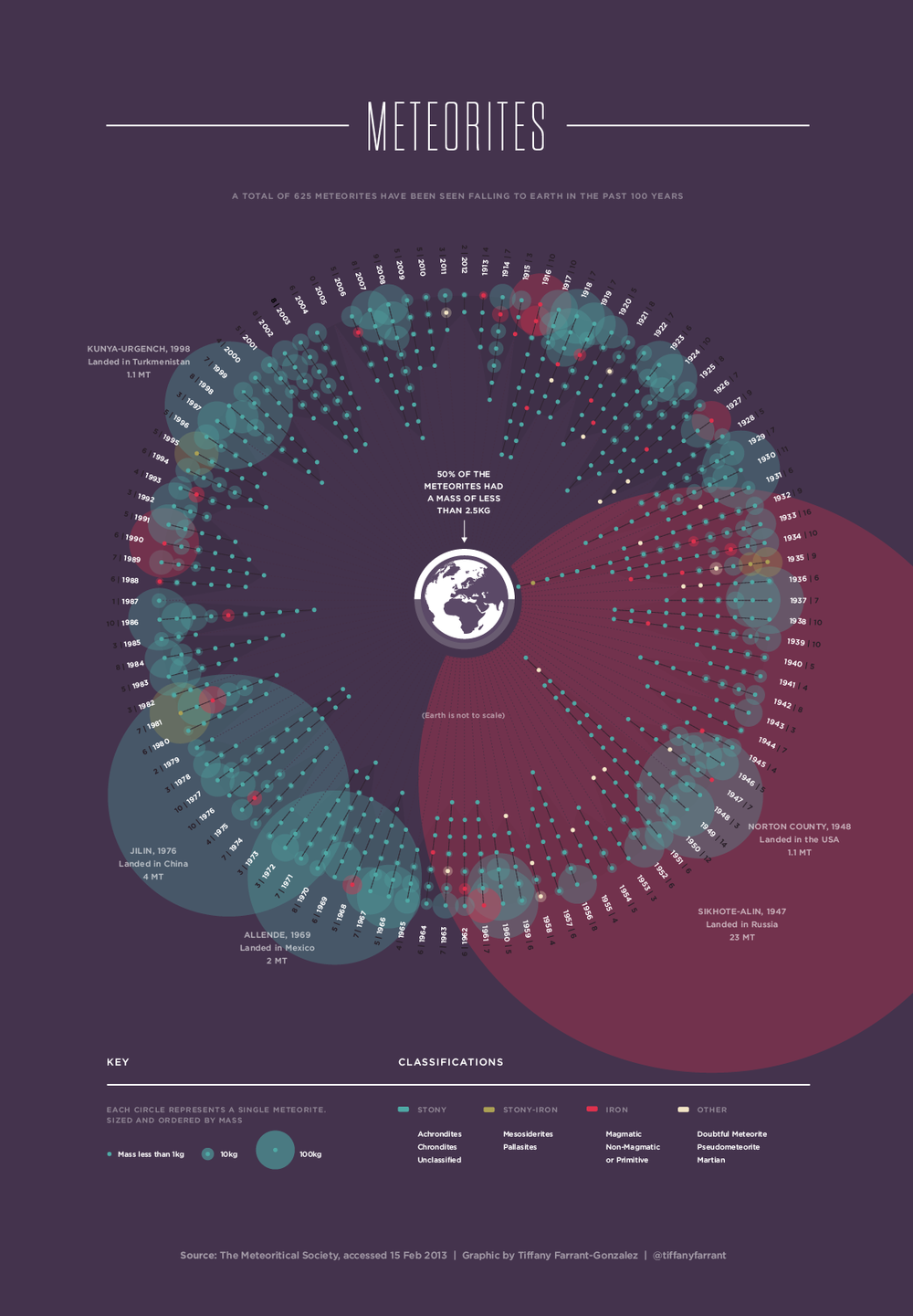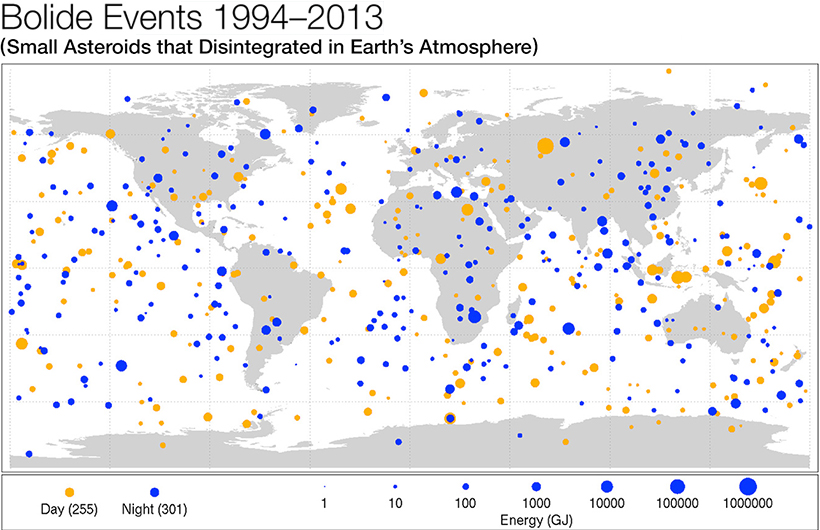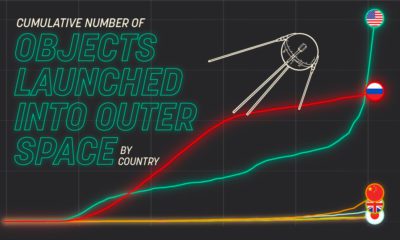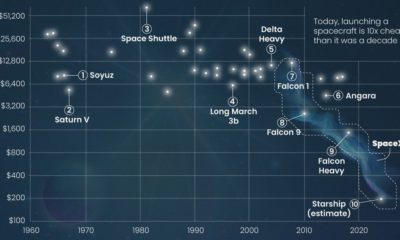Misc
Watching the Sky Fall: Visualizing a Century of Meteorites

Watching the Sky Fall: Visualizing a Century of Meteorites
Astrophysicist Neil DeGrasse Tyson once said “The chances that your tombstone will read ‘Killed by an Asteroid’ are about the same as they’d be for ‘Killed in Airplane Crash’.”
Part of the reason for this is the Earth’s atmospheric ability to burn up inbound space rocks before they reach the surface, a process that ensures that most meteors never become meteorites.
Of the 33,162 meteorites found in the past 100 years, only 625 were seen. Today’s visualization from data designer Tiffany Farrant-Gonzalez groups these 625 observed meteorites by the year they fell, classification, mass, and landing location on Earth.
Asteroid, Meteoroids, Meteors, and Meteorites
Not all flying space rocks are the same. Their origins and trajectories define its type.
Asteroid: A large rocky body in space, in orbit around the Sun.
Meteoroid: Much smaller rocks or particles in orbit around the Sun.
Meteor: If a meteoroid enters the Earth’s atmosphere and vaporizes, it becomes a meteor, or a shooting star.
Meteorite: If a small asteroid or large meteoroid survives its fiery passage through the Earth’s atmosphere and lands on Earth’s surface.
Bolide: A very bright meteor that often explodes in the atmosphere, also known as a fireball.
Classification
This graphic classifies meteorites into four types based on their composition: stony, stony-iron, iron and other.
| Stony | Stony-Iron | Iron | Other |
|---|---|---|---|
| Achondites Chrondites Unclassifed | Mesoiderites Pallasites | Magmatic Non-magmatic or Primitive | Doubtful Meteorites Pseudometeorite |
Top 5 Meteorites by Size
While half of all observed meteorites weighed less than 2.5 kg (5.5 lbs), there are a few exceptional ones that stand out. The graphic highlights the five largest meteorites ever observed, and when they fell:
| Locaton | Size | Year | Type |
|---|---|---|---|
| Sikhote-Alin, Russia | 23 MT | 1947 | Iron |
| Jilin, China | 4 MT | 1976 | Stony |
| Allende, Mexico | 2 MT | 1969 | Stony |
| Norton County, USA | 1.1 MT | 1948 | Stony |
| Kunya-Urgench, Turkmenistan | 1.1 MT | 1998 | Stony |
Each category differs in their amount of iron-nickel metal and what they reveal about the early solar system.
Fireballs in the Sky: Bolides
Small asteroids frequently enter and disintegrate in Earth’s atmosphere randomly around the globe, creating fireballs known as bolides. NASA’s Near-Earth Object Program mapped data gathered by U.S. government sensors from 1994 to 2013.

Source: NASA
The data indicates that small asteroids impacted Earth’s atmosphere, resulting in a bolide (or fireball), on 556 separate occasions over a 20-year period. Almost all asteroids of this size disintegrate in the atmosphere and are harmless.
A notable exception was the Chelyabinsk event in 2013, which was the largest known natural object to have entered Earth’s atmosphere since the 1908 Tunguska event. A house-sized asteroid entered the atmosphere over Chelyabinsk at over 11 miles per second, and blew apart 14 miles above the ground.
The explosion released an energy equivalent to ~440,000 tons of TNT, generating a shock wave that shattered windows over 200 square miles—damaging several buildings and injuring over 1,600 people.
Look Out Above
While the night sky appears to be a beautiful tableau of the cosmos, these two visualizations paint a dramatic galactic battle. Rocks inundate our planet as it moves through the darkness of space. The resiliency of Earth’s atmosphere to erode these invaders has allowed life to flourish—until the next big one comes through.
Remember the Dinosaurs?
VC+
VC+: Get Our Key Takeaways From the IMF’s World Economic Outlook
A sneak preview of the exclusive VC+ Special Dispatch—your shortcut to understanding IMF’s World Economic Outlook report.

Have you read IMF’s latest World Economic Outlook yet? At a daunting 202 pages, we don’t blame you if it’s still on your to-do list.
But don’t worry, you don’t need to read the whole April release, because we’ve already done the hard work for you.
To save you time and effort, the Visual Capitalist team has compiled a visual analysis of everything you need to know from the report—and our VC+ Special Dispatch is available exclusively to VC+ members. All you need to do is log into the VC+ Archive.
If you’re not already subscribed to VC+, make sure you sign up now to access the full analysis of the IMF report, and more (we release similar deep dives every week).
For now, here’s what VC+ members get to see.
Your Shortcut to Understanding IMF’s World Economic Outlook
With long and short-term growth prospects declining for many countries around the world, this Special Dispatch offers a visual analysis of the key figures and takeaways from the IMF’s report including:
- The global decline in economic growth forecasts
- Real GDP growth and inflation forecasts for major nations in 2024
- When interest rate cuts will happen and interest rate forecasts
- How debt-to-GDP ratios have changed since 2000
- And much more!
Get the Full Breakdown in the Next VC+ Special Dispatch
VC+ members can access the full Special Dispatch by logging into the VC+ Archive, where you can also check out previous releases.
Make sure you join VC+ now to see exclusive charts and the full analysis of key takeaways from IMF’s World Economic Outlook.
Don’t miss out. Become a VC+ member today.
What You Get When You Become a VC+ Member
VC+ is Visual Capitalist’s premium subscription. As a member, you’ll get the following:
- Special Dispatches: Deep dive visual briefings on crucial reports and global trends
- Markets This Month: A snappy summary of the state of the markets and what to look out for
- The Trendline: Weekly curation of the best visualizations from across the globe
- Global Forecast Series: Our flagship annual report that covers everything you need to know related to the economy, markets, geopolitics, and the latest tech trends
- VC+ Archive: Hundreds of previously released VC+ briefings and reports that you’ve been missing out on, all in one dedicated hub
You can get all of the above, and more, by joining VC+ today.
-

 Mining1 week ago
Mining1 week agoGold vs. S&P 500: Which Has Grown More Over Five Years?
-

 Markets2 weeks ago
Markets2 weeks agoRanked: The Most Valuable Housing Markets in America
-

 Money2 weeks ago
Money2 weeks agoWhich States Have the Highest Minimum Wage in America?
-

 AI2 weeks ago
AI2 weeks agoRanked: Semiconductor Companies by Industry Revenue Share
-

 Markets2 weeks ago
Markets2 weeks agoRanked: The World’s Top Flight Routes, by Revenue
-

 Countries2 weeks ago
Countries2 weeks agoPopulation Projections: The World’s 6 Largest Countries in 2075
-

 Markets2 weeks ago
Markets2 weeks agoThe Top 10 States by Real GDP Growth in 2023
-

 Demographics2 weeks ago
Demographics2 weeks agoThe Smallest Gender Wage Gaps in OECD Countries















